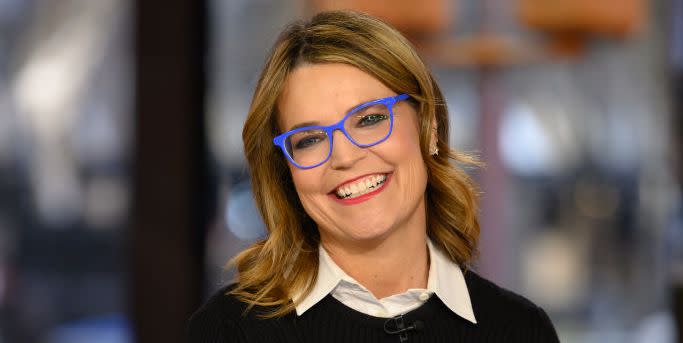Even After Retinal Surgery, Savannah Guthrie Still Has a "Bubble" in Her Eye

If you’ve been following the drama that is Savannah Guthrie’s eye injury and subsequent surgery, you know the Today host has had a tough time lately. But while Guthrie said in a new update that her recovery is “on track,” her doctor revealed that she has an unusual situation right now: She has a bubble in her eye.
A week after undergoing surgery to repair a tear in her retina (the light sensitive tissue in the back of the eye), Guthrie called in to Today on Wednesday and talked about her recovery. “Everything’s on track,” she said. As part of her recovery, Guthrie has to sit facedown for up to three weeks, she previously told People—and that’s been understandably tough.
Guthrie said during her call this week that sitting still has been the hardest part of her recovery. Guthrie’s ophthalmologist, Donald D’Amico, also went on the show to talk about her progress. And, among other things, he revealed that, “she has a bubble in her eye.”
Guthrie shared on Instagram back in November that she got a “large tear” in her retina after her son Charley threw a train at her right eye. Guthrie temporarily lost sight in her eye and has needed several procedures since then, including retinal surgery, to try to help her recover.
A post shared by Savannah Guthrie (@savannahguthrie) on Nov 27, 2019 at 7:40am PST
What does it mean to have a "bubble" in your eye?
It seems weird, but it’s actually a normal part of the surgery Guthrie had, says Vivian Shibayama, O.D., an optometrist with UCLA Health.
Guthrie’s retinal tear was repaired with a type of surgery called a vitrectomy, “which is where they suck out the clear fluid inside the eye so they can repair the tear,” Dr. Shibayama explains. “After they repair the tear, they put in a gas bubble or silicone oil to help the retina stay attached.” (The bubble is later removed during a second surgery, according to the American Academy of Ophthalmology.)
As for how exactly the bubble helps out: "The air bubble will put pressure on the formerly detached portion of the retina, allowing the retina to reposition itself and over time to re-adhere to the underlying layers of the eye," explains Aaron Zimmerman, O.D., an associate professor of clinical optometry at the Ohio State University College of Optometry. "Since gas rises, having the patient face down allows the air bubble to move towards the back of the eye putting pressure on the retina."
"We very commonly put bubbles in the eye during retinal surgery," agrees retinal surgeon Julia Haller, M.D., ophthalmologist in chief of Wills Eye Hospital. "The bubble has a high surface tension. You can put it in the enclosed inner compartment of the eye and it will give gentle, consistent pressure to make sure that whatever part of the retina you're trying to put in place, stays in place."
Once it's done its job, the bubble gets "reabsorbed into the bloodstream," Dr. Haller says, and the amount of time the bubble lasts depends on the type of gas used and its size. "They can last a month or may go away in six or seven days," she says. "The eye replaces the bubble with the fluid that fills the eye."
Per doctor's orders, Guthrie is doing what she can to stay still. Guthrie mentioned binge-watching Netflix and organizing her sock drawer, which she can do while keeping her head down. "She doesn't technically have to sit absolutely still, although that's usually the way to keep yourself in position," Dr. Haller says.
It all sounds intense and complicated, but Guthrie sounds optimistic about her recovery. “It’s all going to turn out okay,” she said.
Like what you just read? You’ll love our magazine! Go here to subscribe. Don’t miss a thing by downloading Apple News here and following Prevention. Oh, and we’re on Instagram too.
You Might Also Like

